Economic Analysis of Tobacco Tax in New Zealand: Policies & Impacts
VerifiedAdded on 2022/09/12
|10
|2189
|26
Essay
AI Summary
This essay provides an economic analysis of tobacco tax in New Zealand, examining the government's intervention to discourage smoking. It begins by summarizing a news article discussing the consecutive tax increases on cigarettes and their impact on dairy owners, including increased robbery rates and declining sales. The essay then delves into the microeconomic principles behind the tax, considering the inelastic demand for cigarettes and the effects of government intervention on market equilibrium. It analyzes the social costs and benefits of the policy, highlighting the negative externalities like increased crime rates that arise from the tax. The essay further suggests an alternative policy, such as licensing, to restrict cigarette consumption without generating adverse effects. The licensing policy is presented as a more efficient approach, avoiding the exploitation perceived in the tax policy and achieving the government's objective of reducing cigarette consumption while minimizing negative consequences. The essay concludes by emphasizing the need for suitable government intervention to mitigate the social costs associated with cigarette consumption, recommending the adoption of a licensing policy over the current tobacco tax.
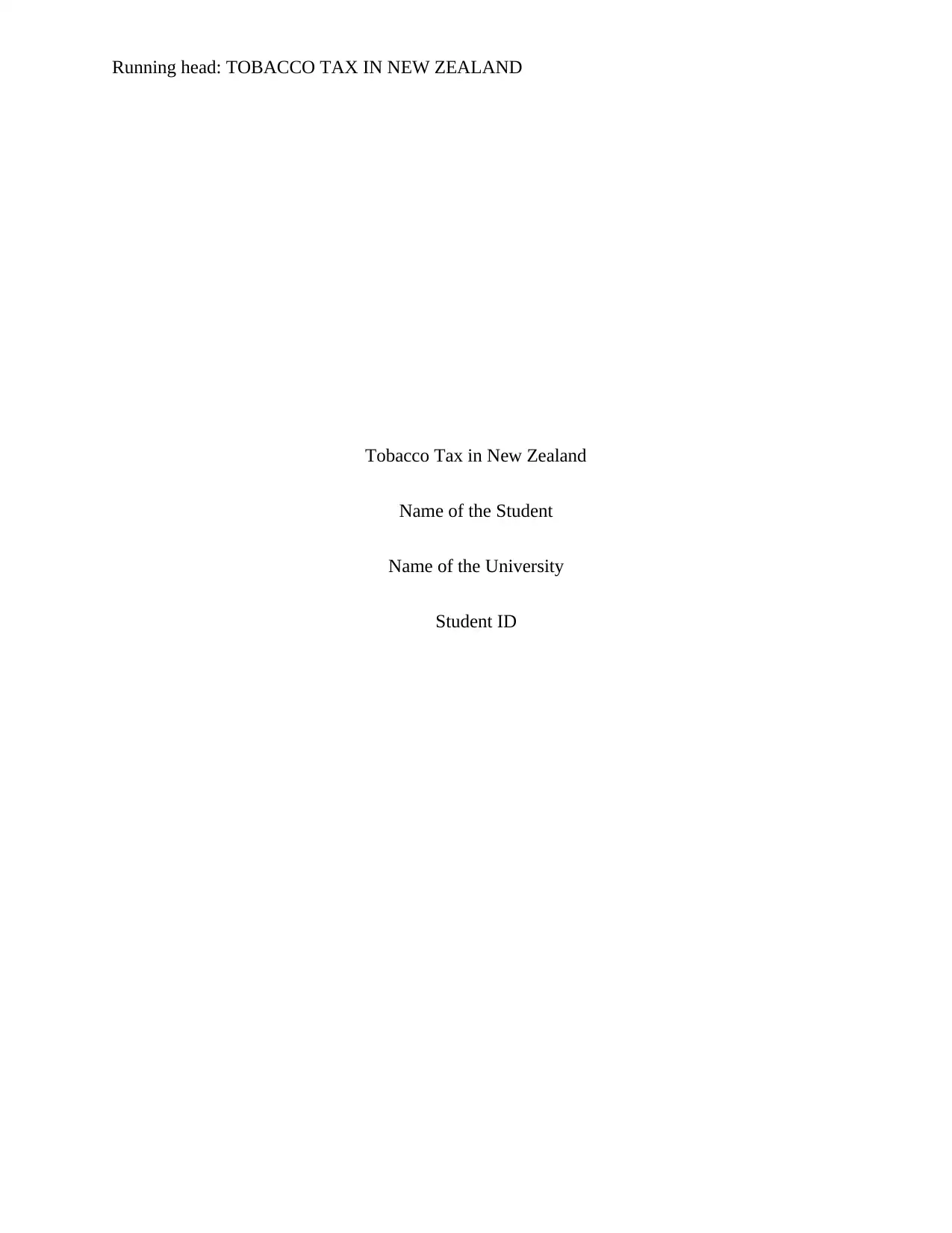
Running head: TOBACCO TAX IN NEW ZEALAND
Tobacco Tax in New Zealand
Name of the Student
Name of the University
Student ID
Tobacco Tax in New Zealand
Name of the Student
Name of the University
Student ID
Paraphrase This Document
Need a fresh take? Get an instant paraphrase of this document with our AI Paraphraser
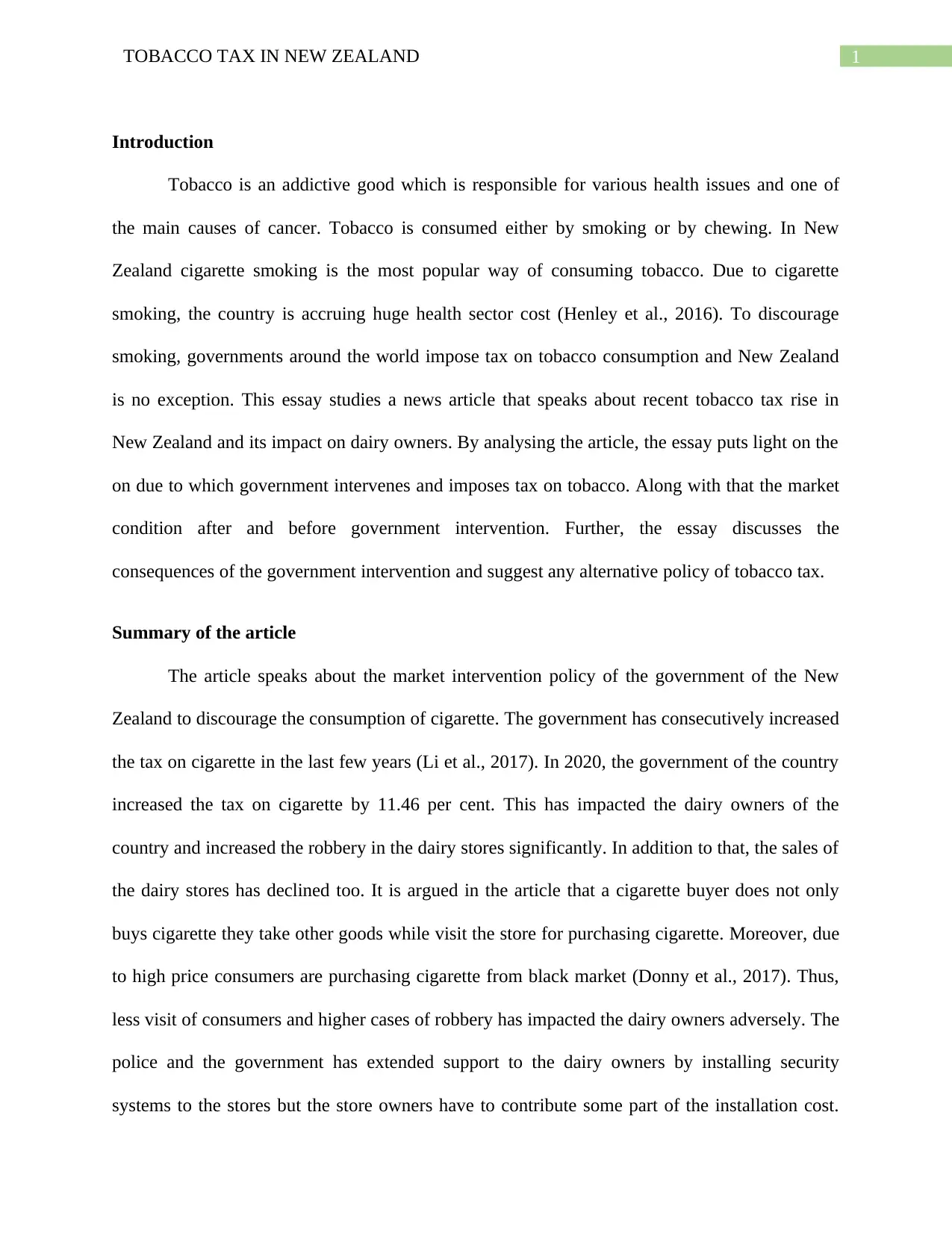
1TOBACCO TAX IN NEW ZEALAND
Introduction
Tobacco is an addictive good which is responsible for various health issues and one of
the main causes of cancer. Tobacco is consumed either by smoking or by chewing. In New
Zealand cigarette smoking is the most popular way of consuming tobacco. Due to cigarette
smoking, the country is accruing huge health sector cost (Henley et al., 2016). To discourage
smoking, governments around the world impose tax on tobacco consumption and New Zealand
is no exception. This essay studies a news article that speaks about recent tobacco tax rise in
New Zealand and its impact on dairy owners. By analysing the article, the essay puts light on the
on due to which government intervenes and imposes tax on tobacco. Along with that the market
condition after and before government intervention. Further, the essay discusses the
consequences of the government intervention and suggest any alternative policy of tobacco tax.
Summary of the article
The article speaks about the market intervention policy of the government of the New
Zealand to discourage the consumption of cigarette. The government has consecutively increased
the tax on cigarette in the last few years (Li et al., 2017). In 2020, the government of the country
increased the tax on cigarette by 11.46 per cent. This has impacted the dairy owners of the
country and increased the robbery in the dairy stores significantly. In addition to that, the sales of
the dairy stores has declined too. It is argued in the article that a cigarette buyer does not only
buys cigarette they take other goods while visit the store for purchasing cigarette. Moreover, due
to high price consumers are purchasing cigarette from black market (Donny et al., 2017). Thus,
less visit of consumers and higher cases of robbery has impacted the dairy owners adversely. The
police and the government has extended support to the dairy owners by installing security
systems to the stores but the store owners have to contribute some part of the installation cost.
Introduction
Tobacco is an addictive good which is responsible for various health issues and one of
the main causes of cancer. Tobacco is consumed either by smoking or by chewing. In New
Zealand cigarette smoking is the most popular way of consuming tobacco. Due to cigarette
smoking, the country is accruing huge health sector cost (Henley et al., 2016). To discourage
smoking, governments around the world impose tax on tobacco consumption and New Zealand
is no exception. This essay studies a news article that speaks about recent tobacco tax rise in
New Zealand and its impact on dairy owners. By analysing the article, the essay puts light on the
on due to which government intervenes and imposes tax on tobacco. Along with that the market
condition after and before government intervention. Further, the essay discusses the
consequences of the government intervention and suggest any alternative policy of tobacco tax.
Summary of the article
The article speaks about the market intervention policy of the government of the New
Zealand to discourage the consumption of cigarette. The government has consecutively increased
the tax on cigarette in the last few years (Li et al., 2017). In 2020, the government of the country
increased the tax on cigarette by 11.46 per cent. This has impacted the dairy owners of the
country and increased the robbery in the dairy stores significantly. In addition to that, the sales of
the dairy stores has declined too. It is argued in the article that a cigarette buyer does not only
buys cigarette they take other goods while visit the store for purchasing cigarette. Moreover, due
to high price consumers are purchasing cigarette from black market (Donny et al., 2017). Thus,
less visit of consumers and higher cases of robbery has impacted the dairy owners adversely. The
police and the government has extended support to the dairy owners by installing security
systems to the stores but the store owners have to contribute some part of the installation cost.
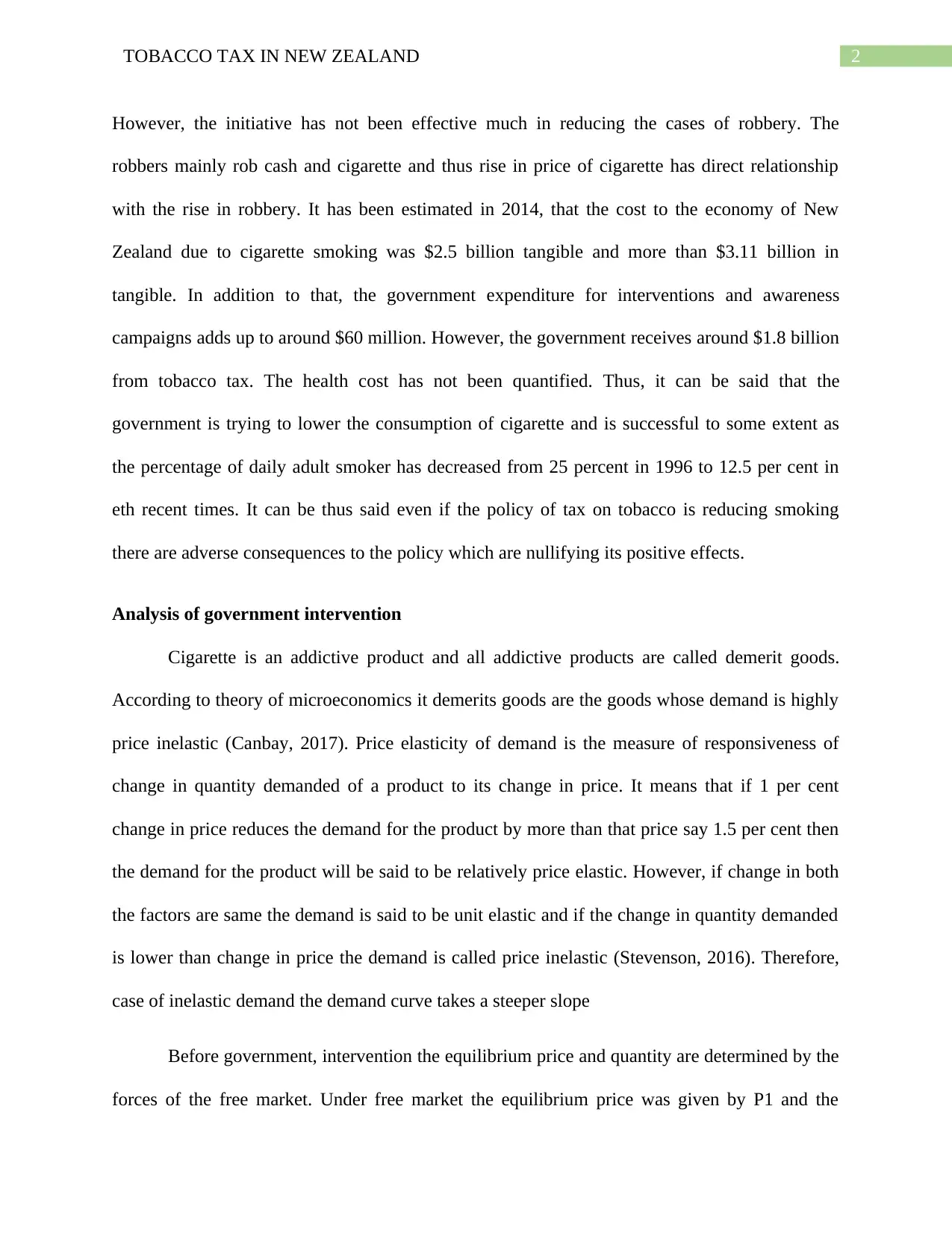
2TOBACCO TAX IN NEW ZEALAND
However, the initiative has not been effective much in reducing the cases of robbery. The
robbers mainly rob cash and cigarette and thus rise in price of cigarette has direct relationship
with the rise in robbery. It has been estimated in 2014, that the cost to the economy of New
Zealand due to cigarette smoking was $2.5 billion tangible and more than $3.11 billion in
tangible. In addition to that, the government expenditure for interventions and awareness
campaigns adds up to around $60 million. However, the government receives around $1.8 billion
from tobacco tax. The health cost has not been quantified. Thus, it can be said that the
government is trying to lower the consumption of cigarette and is successful to some extent as
the percentage of daily adult smoker has decreased from 25 percent in 1996 to 12.5 per cent in
eth recent times. It can be thus said even if the policy of tax on tobacco is reducing smoking
there are adverse consequences to the policy which are nullifying its positive effects.
Analysis of government intervention
Cigarette is an addictive product and all addictive products are called demerit goods.
According to theory of microeconomics it demerits goods are the goods whose demand is highly
price inelastic (Canbay, 2017). Price elasticity of demand is the measure of responsiveness of
change in quantity demanded of a product to its change in price. It means that if 1 per cent
change in price reduces the demand for the product by more than that price say 1.5 per cent then
the demand for the product will be said to be relatively price elastic. However, if change in both
the factors are same the demand is said to be unit elastic and if the change in quantity demanded
is lower than change in price the demand is called price inelastic (Stevenson, 2016). Therefore,
case of inelastic demand the demand curve takes a steeper slope
Before government, intervention the equilibrium price and quantity are determined by the
forces of the free market. Under free market the equilibrium price was given by P1 and the
However, the initiative has not been effective much in reducing the cases of robbery. The
robbers mainly rob cash and cigarette and thus rise in price of cigarette has direct relationship
with the rise in robbery. It has been estimated in 2014, that the cost to the economy of New
Zealand due to cigarette smoking was $2.5 billion tangible and more than $3.11 billion in
tangible. In addition to that, the government expenditure for interventions and awareness
campaigns adds up to around $60 million. However, the government receives around $1.8 billion
from tobacco tax. The health cost has not been quantified. Thus, it can be said that the
government is trying to lower the consumption of cigarette and is successful to some extent as
the percentage of daily adult smoker has decreased from 25 percent in 1996 to 12.5 per cent in
eth recent times. It can be thus said even if the policy of tax on tobacco is reducing smoking
there are adverse consequences to the policy which are nullifying its positive effects.
Analysis of government intervention
Cigarette is an addictive product and all addictive products are called demerit goods.
According to theory of microeconomics it demerits goods are the goods whose demand is highly
price inelastic (Canbay, 2017). Price elasticity of demand is the measure of responsiveness of
change in quantity demanded of a product to its change in price. It means that if 1 per cent
change in price reduces the demand for the product by more than that price say 1.5 per cent then
the demand for the product will be said to be relatively price elastic. However, if change in both
the factors are same the demand is said to be unit elastic and if the change in quantity demanded
is lower than change in price the demand is called price inelastic (Stevenson, 2016). Therefore,
case of inelastic demand the demand curve takes a steeper slope
Before government, intervention the equilibrium price and quantity are determined by the
forces of the free market. Under free market the equilibrium price was given by P1 and the
⊘ This is a preview!⊘
Do you want full access?
Subscribe today to unlock all pages.

Trusted by 1+ million students worldwide
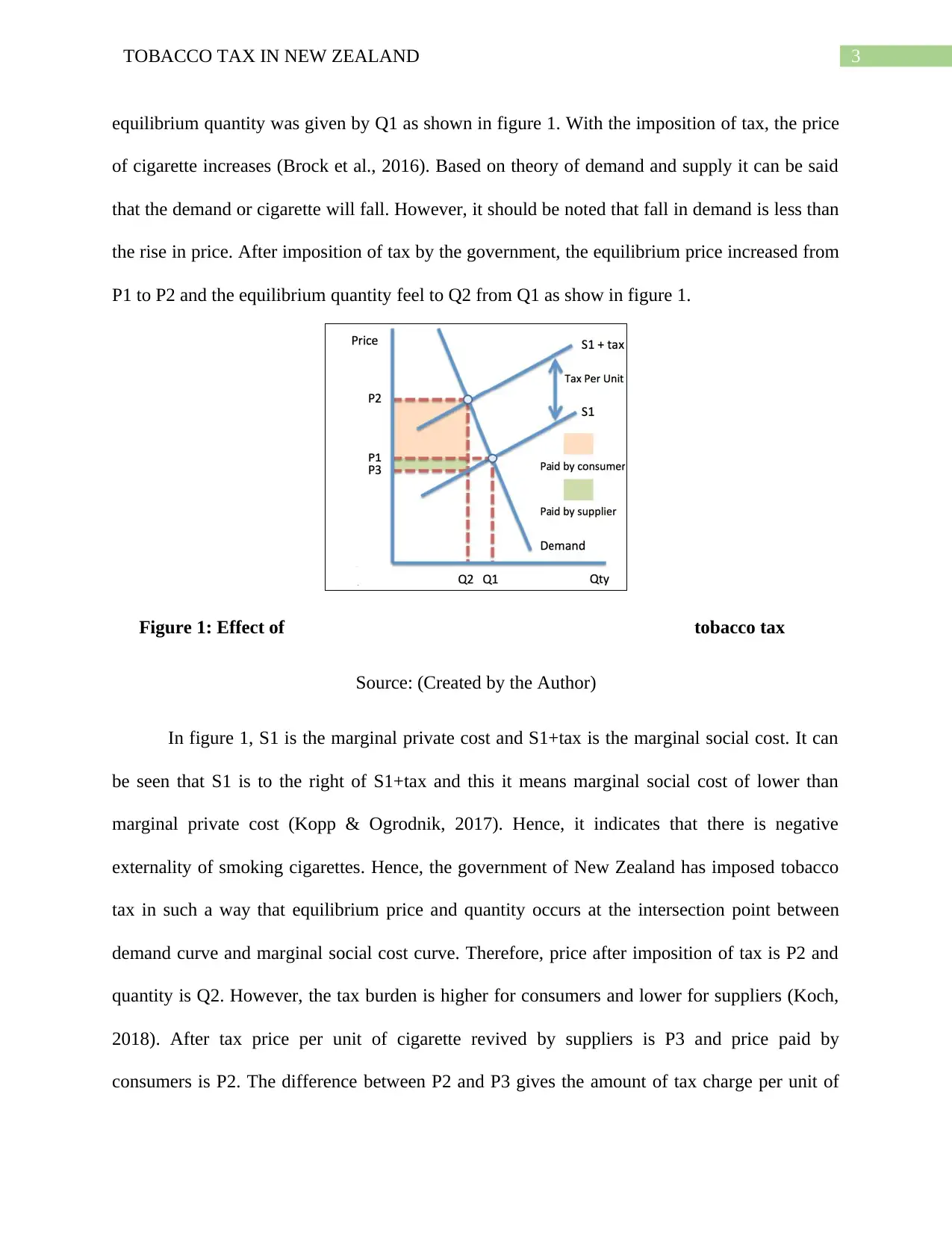
3TOBACCO TAX IN NEW ZEALAND
equilibrium quantity was given by Q1 as shown in figure 1. With the imposition of tax, the price
of cigarette increases (Brock et al., 2016). Based on theory of demand and supply it can be said
that the demand or cigarette will fall. However, it should be noted that fall in demand is less than
the rise in price. After imposition of tax by the government, the equilibrium price increased from
P1 to P2 and the equilibrium quantity feel to Q2 from Q1 as show in figure 1.
Figure 1: Effect of tobacco tax
Source: (Created by the Author)
In figure 1, S1 is the marginal private cost and S1+tax is the marginal social cost. It can
be seen that S1 is to the right of S1+tax and this it means marginal social cost of lower than
marginal private cost (Kopp & Ogrodnik, 2017). Hence, it indicates that there is negative
externality of smoking cigarettes. Hence, the government of New Zealand has imposed tobacco
tax in such a way that equilibrium price and quantity occurs at the intersection point between
demand curve and marginal social cost curve. Therefore, price after imposition of tax is P2 and
quantity is Q2. However, the tax burden is higher for consumers and lower for suppliers (Koch,
2018). After tax price per unit of cigarette revived by suppliers is P3 and price paid by
consumers is P2. The difference between P2 and P3 gives the amount of tax charge per unit of
equilibrium quantity was given by Q1 as shown in figure 1. With the imposition of tax, the price
of cigarette increases (Brock et al., 2016). Based on theory of demand and supply it can be said
that the demand or cigarette will fall. However, it should be noted that fall in demand is less than
the rise in price. After imposition of tax by the government, the equilibrium price increased from
P1 to P2 and the equilibrium quantity feel to Q2 from Q1 as show in figure 1.
Figure 1: Effect of tobacco tax
Source: (Created by the Author)
In figure 1, S1 is the marginal private cost and S1+tax is the marginal social cost. It can
be seen that S1 is to the right of S1+tax and this it means marginal social cost of lower than
marginal private cost (Kopp & Ogrodnik, 2017). Hence, it indicates that there is negative
externality of smoking cigarettes. Hence, the government of New Zealand has imposed tobacco
tax in such a way that equilibrium price and quantity occurs at the intersection point between
demand curve and marginal social cost curve. Therefore, price after imposition of tax is P2 and
quantity is Q2. However, the tax burden is higher for consumers and lower for suppliers (Koch,
2018). After tax price per unit of cigarette revived by suppliers is P3 and price paid by
consumers is P2. The difference between P2 and P3 gives the amount of tax charge per unit of
Paraphrase This Document
Need a fresh take? Get an instant paraphrase of this document with our AI Paraphraser
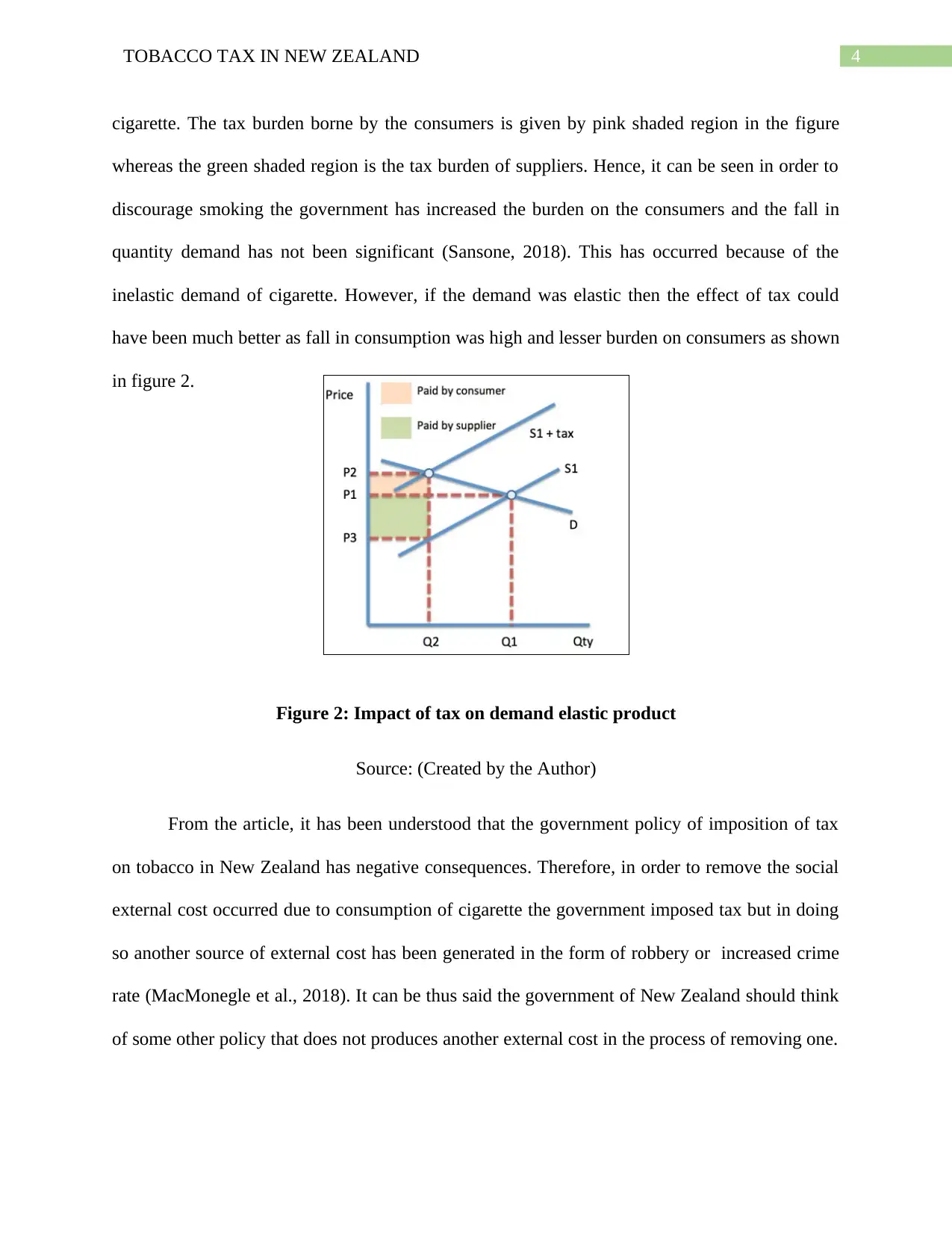
4TOBACCO TAX IN NEW ZEALAND
cigarette. The tax burden borne by the consumers is given by pink shaded region in the figure
whereas the green shaded region is the tax burden of suppliers. Hence, it can be seen in order to
discourage smoking the government has increased the burden on the consumers and the fall in
quantity demand has not been significant (Sansone, 2018). This has occurred because of the
inelastic demand of cigarette. However, if the demand was elastic then the effect of tax could
have been much better as fall in consumption was high and lesser burden on consumers as shown
in figure 2.
Figure 2: Impact of tax on demand elastic product
Source: (Created by the Author)
From the article, it has been understood that the government policy of imposition of tax
on tobacco in New Zealand has negative consequences. Therefore, in order to remove the social
external cost occurred due to consumption of cigarette the government imposed tax but in doing
so another source of external cost has been generated in the form of robbery or increased crime
rate (MacMonegle et al., 2018). It can be thus said the government of New Zealand should think
of some other policy that does not produces another external cost in the process of removing one.
cigarette. The tax burden borne by the consumers is given by pink shaded region in the figure
whereas the green shaded region is the tax burden of suppliers. Hence, it can be seen in order to
discourage smoking the government has increased the burden on the consumers and the fall in
quantity demand has not been significant (Sansone, 2018). This has occurred because of the
inelastic demand of cigarette. However, if the demand was elastic then the effect of tax could
have been much better as fall in consumption was high and lesser burden on consumers as shown
in figure 2.
Figure 2: Impact of tax on demand elastic product
Source: (Created by the Author)
From the article, it has been understood that the government policy of imposition of tax
on tobacco in New Zealand has negative consequences. Therefore, in order to remove the social
external cost occurred due to consumption of cigarette the government imposed tax but in doing
so another source of external cost has been generated in the form of robbery or increased crime
rate (MacMonegle et al., 2018). It can be thus said the government of New Zealand should think
of some other policy that does not produces another external cost in the process of removing one.
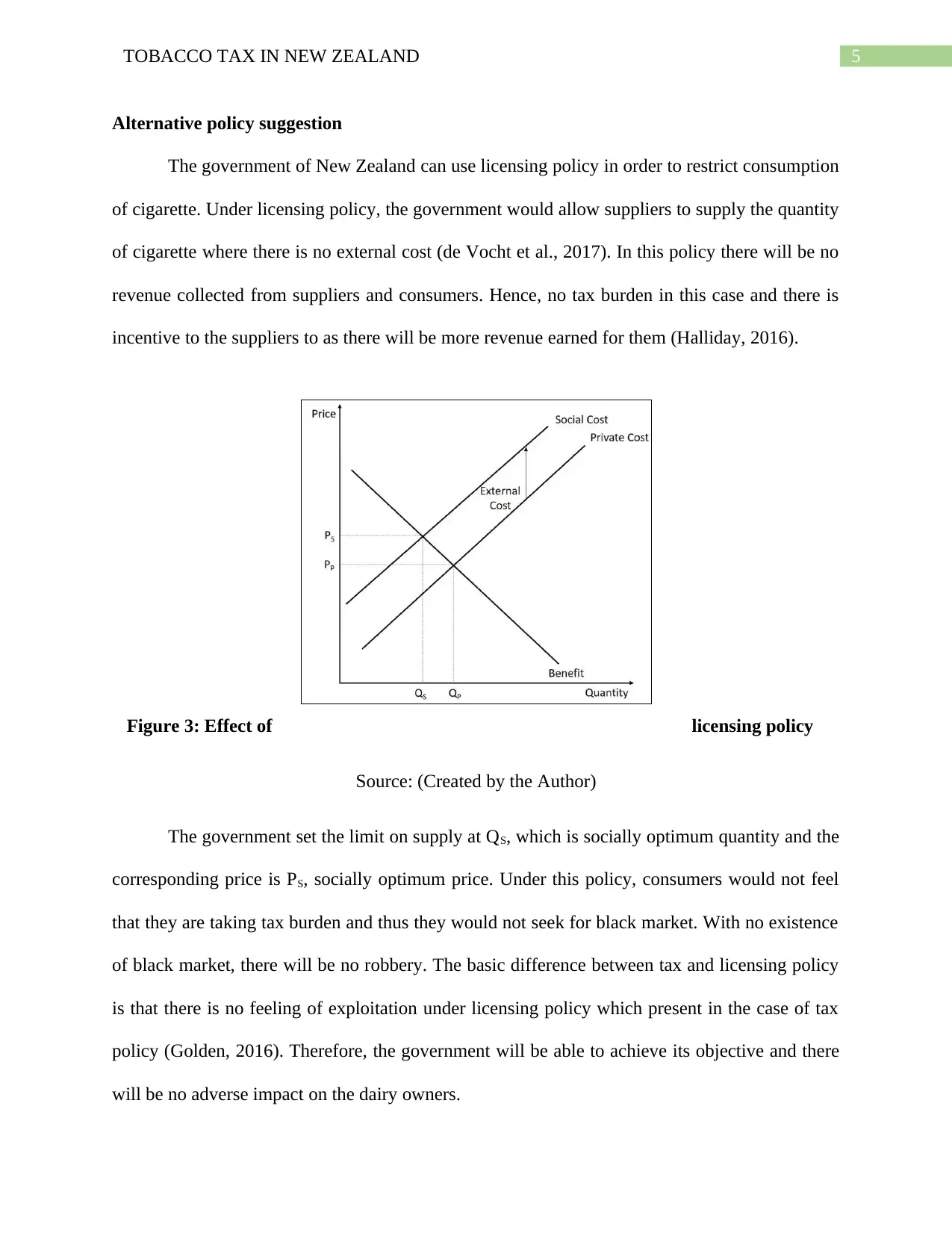
5TOBACCO TAX IN NEW ZEALAND
Alternative policy suggestion
The government of New Zealand can use licensing policy in order to restrict consumption
of cigarette. Under licensing policy, the government would allow suppliers to supply the quantity
of cigarette where there is no external cost (de Vocht et al., 2017). In this policy there will be no
revenue collected from suppliers and consumers. Hence, no tax burden in this case and there is
incentive to the suppliers to as there will be more revenue earned for them (Halliday, 2016).
Figure 3: Effect of licensing policy
Source: (Created by the Author)
The government set the limit on supply at QS, which is socially optimum quantity and the
corresponding price is PS, socially optimum price. Under this policy, consumers would not feel
that they are taking tax burden and thus they would not seek for black market. With no existence
of black market, there will be no robbery. The basic difference between tax and licensing policy
is that there is no feeling of exploitation under licensing policy which present in the case of tax
policy (Golden, 2016). Therefore, the government will be able to achieve its objective and there
will be no adverse impact on the dairy owners.
Alternative policy suggestion
The government of New Zealand can use licensing policy in order to restrict consumption
of cigarette. Under licensing policy, the government would allow suppliers to supply the quantity
of cigarette where there is no external cost (de Vocht et al., 2017). In this policy there will be no
revenue collected from suppliers and consumers. Hence, no tax burden in this case and there is
incentive to the suppliers to as there will be more revenue earned for them (Halliday, 2016).
Figure 3: Effect of licensing policy
Source: (Created by the Author)
The government set the limit on supply at QS, which is socially optimum quantity and the
corresponding price is PS, socially optimum price. Under this policy, consumers would not feel
that they are taking tax burden and thus they would not seek for black market. With no existence
of black market, there will be no robbery. The basic difference between tax and licensing policy
is that there is no feeling of exploitation under licensing policy which present in the case of tax
policy (Golden, 2016). Therefore, the government will be able to achieve its objective and there
will be no adverse impact on the dairy owners.
⊘ This is a preview!⊘
Do you want full access?
Subscribe today to unlock all pages.

Trusted by 1+ million students worldwide

6TOBACCO TAX IN NEW ZEALAND
Conclusion
The above discussion of tobacco tax in New Zealand leads to the conclusion that there is
need for government intervention to lower social cost occurring due to consumption of cigarette
but with implementation of suitable policy. The tobacco tax policy in New Zealand has not done
well since it gave rise to crime rates in the form of robbery. Therefore, such a policy should be
abandoned and new policy like licensing should be introduced. The analysis of the licensing
policy showed that it is much more efficient in case reducing the consumption of cigarette than
tobacco tax as it does not generate any adverse effects. Thus, the government should consider
licensing policy implementation.
Conclusion
The above discussion of tobacco tax in New Zealand leads to the conclusion that there is
need for government intervention to lower social cost occurring due to consumption of cigarette
but with implementation of suitable policy. The tobacco tax policy in New Zealand has not done
well since it gave rise to crime rates in the form of robbery. Therefore, such a policy should be
abandoned and new policy like licensing should be introduced. The analysis of the licensing
policy showed that it is much more efficient in case reducing the consumption of cigarette than
tobacco tax as it does not generate any adverse effects. Thus, the government should consider
licensing policy implementation.
Paraphrase This Document
Need a fresh take? Get an instant paraphrase of this document with our AI Paraphraser
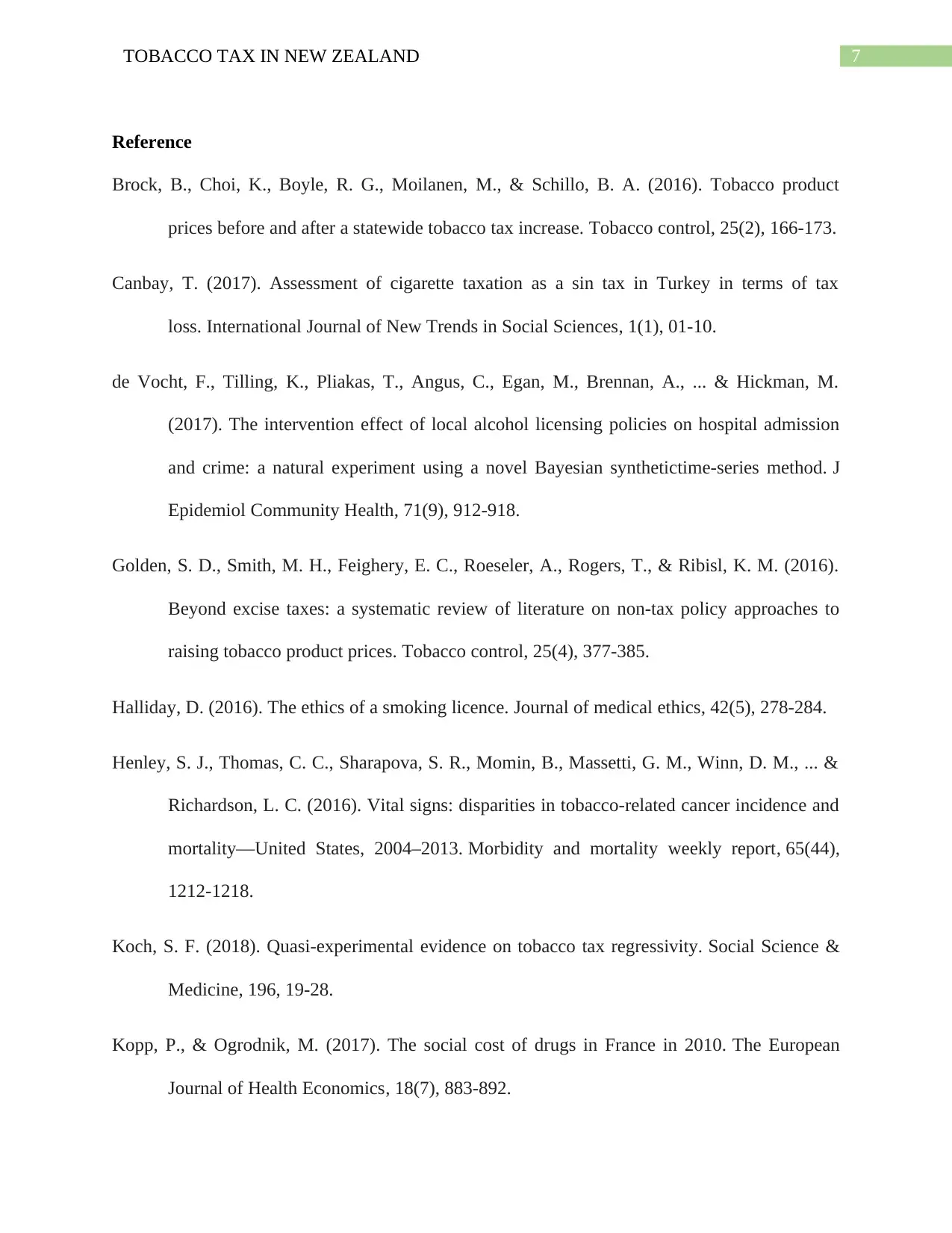
7TOBACCO TAX IN NEW ZEALAND
Reference
Brock, B., Choi, K., Boyle, R. G., Moilanen, M., & Schillo, B. A. (2016). Tobacco product
prices before and after a statewide tobacco tax increase. Tobacco control, 25(2), 166-173.
Canbay, T. (2017). Assessment of cigarette taxation as a sin tax in Turkey in terms of tax
loss. International Journal of New Trends in Social Sciences, 1(1), 01-10.
de Vocht, F., Tilling, K., Pliakas, T., Angus, C., Egan, M., Brennan, A., ... & Hickman, M.
(2017). The intervention effect of local alcohol licensing policies on hospital admission
and crime: a natural experiment using a novel Bayesian synthetictime-series method. J
Epidemiol Community Health, 71(9), 912-918.
Golden, S. D., Smith, M. H., Feighery, E. C., Roeseler, A., Rogers, T., & Ribisl, K. M. (2016).
Beyond excise taxes: a systematic review of literature on non-tax policy approaches to
raising tobacco product prices. Tobacco control, 25(4), 377-385.
Halliday, D. (2016). The ethics of a smoking licence. Journal of medical ethics, 42(5), 278-284.
Henley, S. J., Thomas, C. C., Sharapova, S. R., Momin, B., Massetti, G. M., Winn, D. M., ... &
Richardson, L. C. (2016). Vital signs: disparities in tobacco-related cancer incidence and
mortality—United States, 2004–2013. Morbidity and mortality weekly report, 65(44),
1212-1218.
Koch, S. F. (2018). Quasi-experimental evidence on tobacco tax regressivity. Social Science &
Medicine, 196, 19-28.
Kopp, P., & Ogrodnik, M. (2017). The social cost of drugs in France in 2010. The European
Journal of Health Economics, 18(7), 883-892.
Reference
Brock, B., Choi, K., Boyle, R. G., Moilanen, M., & Schillo, B. A. (2016). Tobacco product
prices before and after a statewide tobacco tax increase. Tobacco control, 25(2), 166-173.
Canbay, T. (2017). Assessment of cigarette taxation as a sin tax in Turkey in terms of tax
loss. International Journal of New Trends in Social Sciences, 1(1), 01-10.
de Vocht, F., Tilling, K., Pliakas, T., Angus, C., Egan, M., Brennan, A., ... & Hickman, M.
(2017). The intervention effect of local alcohol licensing policies on hospital admission
and crime: a natural experiment using a novel Bayesian synthetictime-series method. J
Epidemiol Community Health, 71(9), 912-918.
Golden, S. D., Smith, M. H., Feighery, E. C., Roeseler, A., Rogers, T., & Ribisl, K. M. (2016).
Beyond excise taxes: a systematic review of literature on non-tax policy approaches to
raising tobacco product prices. Tobacco control, 25(4), 377-385.
Halliday, D. (2016). The ethics of a smoking licence. Journal of medical ethics, 42(5), 278-284.
Henley, S. J., Thomas, C. C., Sharapova, S. R., Momin, B., Massetti, G. M., Winn, D. M., ... &
Richardson, L. C. (2016). Vital signs: disparities in tobacco-related cancer incidence and
mortality—United States, 2004–2013. Morbidity and mortality weekly report, 65(44),
1212-1218.
Koch, S. F. (2018). Quasi-experimental evidence on tobacco tax regressivity. Social Science &
Medicine, 196, 19-28.
Kopp, P., & Ogrodnik, M. (2017). The social cost of drugs in France in 2010. The European
Journal of Health Economics, 18(7), 883-892.

8TOBACCO TAX IN NEW ZEALAND
Li, J., Newcombe, R., Guiney, H., & Walton, D. (2017). Impact on Smoking Behavior of the
New Zealand Annual Increase in Tobacco Tax: Data for the Fifth and Sixth Year of
Increases. Nicotine & Tobacco Research, 19(12), 1491-1498.
MacMonegle, A. J., Nonnemaker, J., Duke, J. C., Farrelly, M. C., Zhao, X., Delahanty, J. C., ...
& Allen, J. A. (2018). Cost-effectiveness analysis of The Real Cost campaign's effect on
smoking prevention. American journal of preventive medicine, 55(3), 319-325.
Sansone, G. (2018). Literature Review on the Impact of Tobacco Price and Tax Policies on
Women.
Stevenson, R. (2016). 11 The Economics of Drug Policy. Policing and Prescribing: The British
System of Drug Control, 200.
Li, J., Newcombe, R., Guiney, H., & Walton, D. (2017). Impact on Smoking Behavior of the
New Zealand Annual Increase in Tobacco Tax: Data for the Fifth and Sixth Year of
Increases. Nicotine & Tobacco Research, 19(12), 1491-1498.
MacMonegle, A. J., Nonnemaker, J., Duke, J. C., Farrelly, M. C., Zhao, X., Delahanty, J. C., ...
& Allen, J. A. (2018). Cost-effectiveness analysis of The Real Cost campaign's effect on
smoking prevention. American journal of preventive medicine, 55(3), 319-325.
Sansone, G. (2018). Literature Review on the Impact of Tobacco Price and Tax Policies on
Women.
Stevenson, R. (2016). 11 The Economics of Drug Policy. Policing and Prescribing: The British
System of Drug Control, 200.
⊘ This is a preview!⊘
Do you want full access?
Subscribe today to unlock all pages.

Trusted by 1+ million students worldwide

9TOBACCO TAX IN NEW ZEALAND
Appendix
https://www.stuff.co.nz/national/crime/118689993/fears-tobacco-tax-hike-brings-uncertain-
future-for-dairy-owners
Appendix
https://www.stuff.co.nz/national/crime/118689993/fears-tobacco-tax-hike-brings-uncertain-
future-for-dairy-owners
1 out of 10
Related Documents
Your All-in-One AI-Powered Toolkit for Academic Success.
+13062052269
info@desklib.com
Available 24*7 on WhatsApp / Email
![[object Object]](/_next/static/media/star-bottom.7253800d.svg)
Unlock your academic potential
Copyright © 2020–2025 A2Z Services. All Rights Reserved. Developed and managed by ZUCOL.





